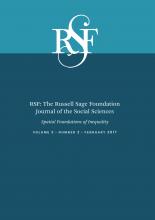Research Article
Open Access
Defensible Spaces in Philadelphia: Exploring Neighborhood Boundaries Through Spatial Analysis
Rory Kramer
RSF: The Russell Sage Foundation Journal of the Social Sciences February 2017, 3 (2) 81-101; DOI: https://doi.org/10.7758/RSF.2017.3.2.04
Rory Kramer
aAssistant professor of sociology at Villanova University

REFERENCES
- ↵
- Ananat, Elizabeth Oltmans
- ↵Anderson, Elijah 2011. The Cosmopolitan Canopy: Race and Civility in Everyday Life. New York: W. W. Norton.
- Bader, Michael. 2010. “Evolution of Racial and Ethnic Segregation: Pace and Place of Neighborhood Change.” Unpublished paper. American University, Washington, D.C.
- ↵Bailey, Trevor, and Tony Gattrell. 1995. Interactive Spatial Data Analysis. Harlow, Essex, UK: Prentice Hall.
- ↵
- ↵
- Charles, Camille Zubrinsky
- ↵Charles, Camille Zubrinsky. 2006. Won’t You Be My Neighbor? Race, Class, and Residence in Los Angeles. New York: Russell Sage Foundation.
- ↵Countryman, Matthew. 2005. Up South: Civil Rights and Black Power in Philadelphia. Philadelphia: University of Pennsylvania Press.
- ↵
- ↵Davis, Mike. 1992. City of Quartz. New York: Vintage Books.
- ↵Deener, Andrew. 2012. Venice: A Contested Bohemia in Los Angeles. Chicago: University of Chicago Press.
- ↵
- Du Bois, W. E. B. 1996. The Philadelphia Negro: A Social Study. Reprint. Philadelphia: University of Pennsylvania Press. First published 1899.
- ↵Durlauf, Steven. 2004. “Neighborhood Effects.” In Handbook of Regional and Urban Economics, vol. 4, edited by J. Vernon Henderson and Jacques-François Thisse. Amsterdam: Elsevier.
- ↵
- Ferman, Barbara,
- Theresa Singleton, , and
- Don DeMarco
- ↵
- Galster, George
- ↵
- Galster, George
- ↵
- ↵
- ↵Grannis, Rick. 2009. From the Ground Up: Translating Geography into Community Through Neighbor Networks. Princeton, N.J.: Princeton University Press.
- ↵
- Grengs, Joe
- ↵Harvey, David. 2000. Spaces of Hope. Berkeley: University of California Press.
- ↵Hunter, Albert. 1982. Symbolic Communities, 2nd ed. Chicago: University of Chicago Press.
- ↵Hunter, Marcus Anthony. 2013. Black Citymakers: How the Philadelphia Negro Changed Urban America. New York: Oxford University Press.
- ↵
- ↵
- Hyra, Derek,
- Gregory Squires, ,
- Robert Renner, , and
- David Kirk
- ↵Jacobs, Jane. 1961. The Death and Life of Great American Cities. New York: Random House.
- ↵Kramer, Rory. 2012. “What Is on the Other Side of the Tracks? A Spatial Examination of Neighborhood Boundaries and Segregation.” PhD diss., University of Pennsylvania.
- ↵
- Krysan, Maria, and
- Reynolds Farley
- ↵
- ↵Lamont, Michelle. 1992. Money, Morals, and Manners: The Culture of the French and American Upper-Middle Class. Chicago: University of Chicago Press.
- ↵Lamont, Michelle 2000.The Dignity of Working Men: Morality and the Boundaries of Race, Class, and Immigration. New York: Russell Sage Foundation.
- ↵
- Lee, Barrett,
- Sean Reardon, ,
- Glenn Firebaugh, ,
- Chad Farrell, ,
- Stephen Matthews, , and
- David O’Sullivan
- ↵
- Legewie, Joscha, and
- Merlin Schaeffer
- ↵
- Leventhal, Tama, and
- Jeanne Brooks-Gunn
- ↵Lin, Jennifer. 1993. “In Kensington, Two Groups Live So Close, Yet So Far Away.” Philadelphia Inquirer, August 8, 1993. Accessed January 14, 2015. http://articles.philly.com/1993–08–08/news/25967781_1_spray-painted-windows-police-and-clergy.
- ↵
- ↵Logan, John, and Charles Zhang. 2011. “Global Neighborhoods: New Evidence from Census 2010.” US2010 Project. New York: Russell Sage Foundation.
- ↵
- Martin, Deborah G
- ↵Massey, Douglas, and Nancy Denton. 1993. American Apartheid. Cambridge, Mass.: Harvard University Press.
- ↵
- ↵Morris, Aldon. 2015. The Scholar Denied: W. E. B. Du Bois and the Birth of Modern Sociology. Cambridge, Mass.: Harvard University Press.
- ↵Openshaw, Stan, and Peter Taylor. 1979. “A Million or so Correlation Coefficients: Three Experiments on the Modifiable Areal Unit Problem.” In Statistical Applications for the Spatial Sciences, edited by Neil Wrigley. London: Pion.
- ↵Perkiss, Abigail. 2014. Making Good Neighbors: Civil Rights, Liberalism, and Integration in Postwar Philadelphia. Ithaca, N.Y.: Cornell University Press.
- ↵Peterson, Ruth, and Laurie Krivo. 2010. Divergent Social Worlds: Neighborhood Crime and Racial-Spatial Divide. New York: Russell Sage Foundation.
- ↵Reardon, Sean, and Kendra Bischoff. 2011. “Growth in the Residential Segregation of Families by Income, 1970–2009.” US2010 Project. New York: Russell Sage Foundation.
- ↵Roberto, Elizabeth. 2015. “Spatial Boundaries and the Local Context of Residential Segregation.” Cornell University Library. Accessed July 25, 2016. http://arxiv.org/abs/1509.02574.
- ↵
- Rothwell, Jonathan, and
- Douglas Massey
- ↵
- Rugh, Jacob, and
- Douglas Massey
- ↵Sampson, Robert. 2012. Great American City. Chicago: University of Chicago Press.
- ↵
- Sampson, Robert,
- Patrick Sharkey, , and
- Stephen Raudenbush
- ↵Sharkey, Patrick. 2014. Stuck in Place: Urban Neighborhoods and the End of Progress Toward Racial Inequality. Chicago: University of Chicago Press.
- ↵Smith, Sandy. 2014. “Philly Neighborhood Focuses on Schools as Key to Diversity.” Next City. Accessed June 9, 2015. http://nextcity.org/daily/entry/philadelphia-diversity-mt-airy-schools.
- ↵Suttles, Gerald. 1972. The Social Construction of Communities. Chicago: University of Chicago Press.
- U.S. Census Bureau. 2011. “2010 Census Summary File 1.” Washington: Government Printing Office.
- ↵
- Wimmer, Andreas
- ↵
- Wodtke, Geoffrey,
- David Harding, , and
- Felix Elwert
- ↵Wolfinger, James. 2007. Philadelphia Divided: Race and Politics in the City of Brotherly Love. Chapel Hill: University of North Carolina Press.
- ↵Zuylen-Wood, Simon van. 2013. “Philadelphia Is Ori Feibush’s World, We Just Live in It.” Philadelphia Magazine. Accessed June 12, 2015. http://www.phillymag.com/articles/philadelphia-ori-feibushs-world-live/.
In this issue
Defensible Spaces in Philadelphia: Exploring Neighborhood Boundaries Through Spatial Analysis
Rory Kramer
RSF: The Russell Sage Foundation Journal of the Social Sciences Feb 2017, 3 (2) 81-101; DOI: 10.7758/RSF.2017.3.2.04
Jump to section
Related Articles
- No related articles found.





